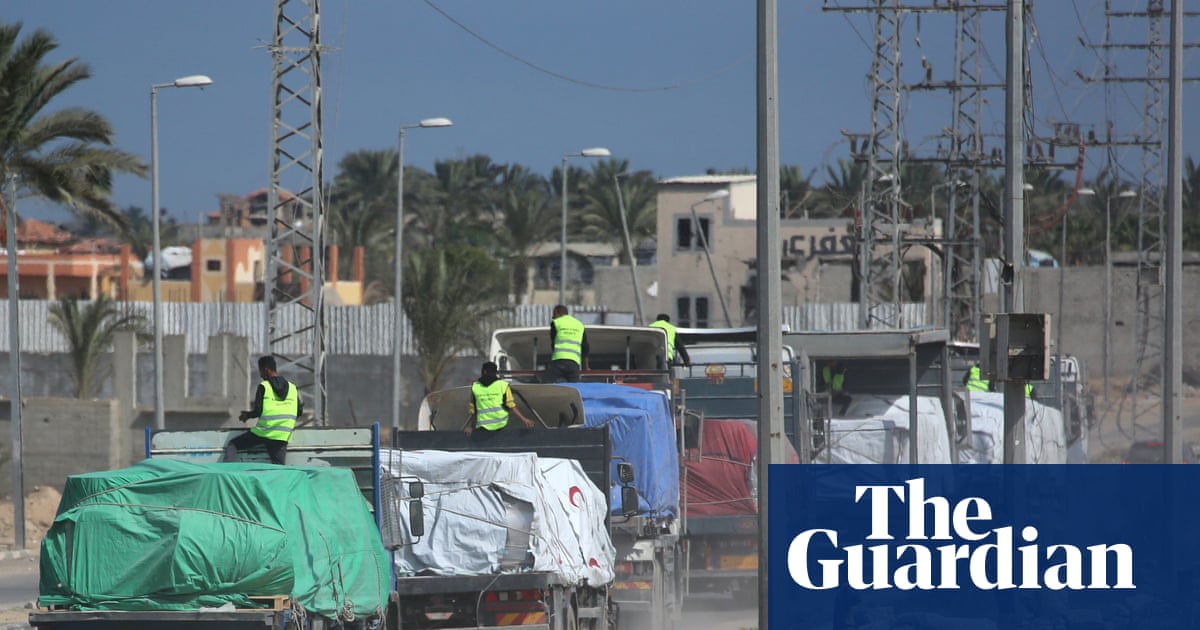Gaza aid still critically scarce, say agencies, as Israel delays convoys | Gaza

Aid remains critically scarce in Gaza one week into the ceasefire, humanitarian agencies have warned, as Israel delays the entry of food convoys into the territory. The Israeli government and Hamas continue to trade blame over violations of the truce.
The UN World Food Programme (WFP) said on Friday that it had brought about 560 tonnes of food a day on average into Gaza since the ceasefire began, but it was still below what was needed.
Its spokesperson Abeer Etefa said: “We’re still below what we need, but we’re getting there … The ceasefire has opened a narrow window of opportunity, and WFP is moving very quickly and swiftly to scale up food assistance.”
Aid trucks have been lined up at the Kissufim crossing between Israel and Gaza since the early hours. It is one of the few entry points where lorries load supplies on the Israeli side before heading back into Gaza.
As aid entry was delayed into the strip, Israel continued to fire on Palestinians. The Israeli army shelled a car which had crossed past the ceasefire line with Israel in the Zeytoun neighbourhood of Gaza, killing nine people.
“They had crossed the so-called ‘yellow line’, an imaginary boundary mentioned by the Israeli army. I am certain the family couldn’t distinguish between the yellow and red lines because there are no actual physical markers on the ground,” said Mahmoud Basal, the spokesperson for the Gaza civil defence.
The Israeli defence minister, Israel Katz, said on Friday that the yellow line in Gaza will soon be physically marked.
Drivers often wait for hours for clearance to pass, with long delays leaving many stranded in the heat. Although 600 trucks are meant to enter Gaza each day, fewer than half that number make it through, and even that target falls short of the vast needs on the ground. Stringent restrictions on what can be transported means that some convoys are forced to turn back.
During the war, Israel shut down entry and exit routes, largely blocking off food and medicine, which in turn caused a famine in parts of Gaza.
The UN said it would take time to reverse the famine in Gaza and urged the opening of all crossing points. “It’s going to take some time to scale back the famine,” Etefa said, citing how the WFP had five distribution points up and running but wanted to get to 145 in order to “flood Gaza with food”.
The WFP said it had not begun distributions in Gaza City, pointing to the continued closure of two border crossings, Zikim and Erez, to the north of Gaza where the humanitarian crisis is most acute.
“Access to Gaza City and northern Gaza is extremely challenging,” Etefa said, adding that convoys of wheat flour and ready-to-eat food parcels were struggling to move along damaged or blocked roads from the south of the devastated territory.
Though small amounts of nutrition products have reached the north, relief convoys were still unable to move significant quantities of food there, as well as other areas.
“We’ve had 57 trucks yesterday [enter southern and central Gaza]. We consider this a breakthrough, but we’re not yet at the level of around 80-100 trucks a day,” Etefa said.
The ceasefire deal, signed last week, between Israel and Hamas raised hopes of a surge of humanitarian aid finally reaching the territory after two years of war, but most restrictions have remained in place, throttling the supply of desperately needed assistance.
Tens of thousands of tonnes of supplies are positioned in neighbouring countries such as Jordan and Egypt. Under the terms of the first phase of the deal, aid was meant to surge into the territory and humanitarian groups were preparing to bring large amounts of vital aid to starving people in Gaza this weekend.
The World Health Organization (WHO) has warned that infectious diseases are “spiralling out of control”, with only 13 of the territory’s 36 hospitals even partially functioning.
“Whether meningitis … diarrhoea, respiratory illnesses, we’re talking about a mammoth amount of work,” Hanan Balkhy, the regional director for the UN health body, told Agence France-Presse in Cairo.
In a separate update, the WHO office in the occupied Palestinian territory said on Thursday it had been scaling up deliveries of medical supplies to health facilities since the Gaza ceasefire came into effect.
But as Israel and Hamas continue to trade blame over breaches of the truce, there is a risk of the humanitarian crisis in Gaza deepening by the day.
Israel accused Hamas of violating the ceasefire agreement by failing to return the remains of deceased hostages. On Monday, Hamas returned the last 20 surviving hostages but has handed back only nine of 28 deceased captives, saying it would need specialist recovery equipment to retrieve the rest from the ruins of Gaza.
Turkey has deployed dozens of disaster relief specialists to help search for bodies under the rubble in Gaza.
Gaza’s civil defence agency estimates that the bodies of about 10,000 people are trapped under the debris and collapsed buildings. The task ahead of the rescuers is immense given that there is an estimated 60m tonnes of rubble across the territory.
The US president, Donald Trump, has said he would consider allowing Israeli forces to resume fighting in Gaza if Hamas failed to uphold its end of the ceasefire deal. “Israel will return to those streets as soon as I say the word. If Israel could go in and knock the crap of them, they’d do that,” Trump was quoted as saying to CNN in a brief telephone call when asked what would happen if Hamas refused to disarm.
Source link

